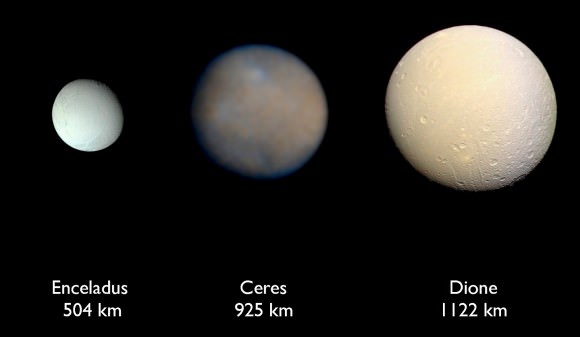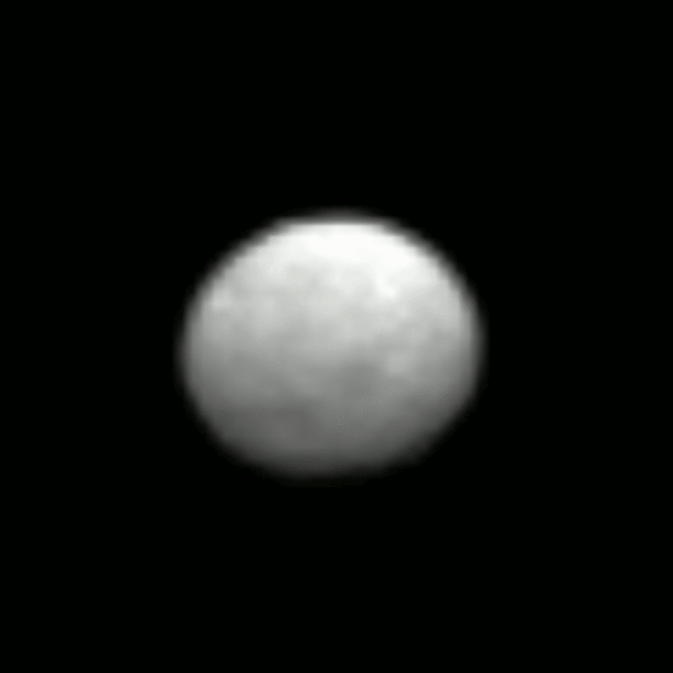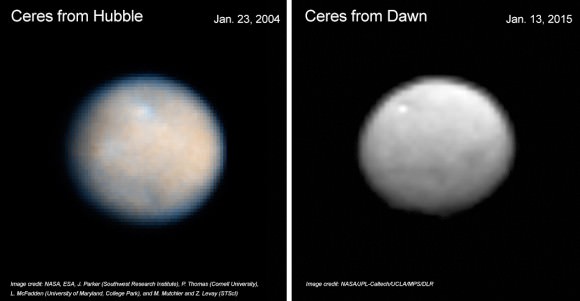When the Dawn mission was in its planning stages, Ceres was considered an asteroid. But in 2006, a year before the mission launched, the International Astronomical Union formed a new class of solar system objects known as dwarf planets, and since by definition a dwarf planet is spherical and travels in an orbit around the Sun, Ceres fit that definition perfectly.
But since it’s located in the Asteroid Belt, we still tend to think of Ceres as an asteroid. So, how does Ceres compare to other asteroids?
Dr. Paul Schenk, who is a participating scientist on the Dawn mission, recently put together some graphics on his website and the one above compares Ceres to other asteroids that we’ve visited with spacecraft.
Of course, Ceres is bigger (it’s the biggest object in the Asteroid Belt) and more spherical than the other asteroids. When it comes right down to it, Ceres doesn’t look much like an asteroid at all!
“Ceres is most similar in size to several of Saturn’s icy moons and may be similar internally as well, being composed of 25% water ice by mass,” Schenk noted on his website.

And water is one of the most interesting and mysterious aspects of Ceres. A year ago, the Herschel space telescope discovered water vapor around Ceres, and the vapor could be emanating from water plumes — much like those that are on Saturn’s moon Enceladus – or it could be from cryovolcanism from geysers or icy volcano.
“The water vapor question is one of the most interesting things we will look for,” Schenk told Universe Today. “What is its source, what does it indicate about the interior and activity level within Ceres? Is Ceres active, very ancient, or both? Does it go back to the earliest Solar System? Those are the questions we hope to answer with Dawn.”
Some scientists also think Ceres may have an ocean and possibly an atmosphere, which makes Dawn’s arrival at Ceres in March one of the most exciting planetary events of 2015, in addition to New Horizon’s arrival at Pluto.
“Since we don’t know why the water vapor venting has happened, or even if it continues, it’s hard to say much more than that,” Schenk said via email, “but it is theoretically possible that some liquid water still exists within Ceres. Dawn will try to determine if that is true.”
One of the possibilities that has been discussed is that if the water vapor is confirmed, Ceres could potentially host microbial life. I asked Schenk what other factors would have to be present in order for that to have occurred?
“The presence of carbon molecules is often regarded as necessary for life,” he replied, “and we think we see that on the surface spectroscopically in the form of carbonates and clays. So, I think the questions will be, whether there is actually liquid water of any kind, whether the carbon compounds are just a surface coating or in the interior, and whether Ceres has ever been warm. If those are true then some sort of prebiotic or biotic activity is in play.”
Since we do not know the answer to any of these questions yet, Schenk says Dawn’s visit to Ceres should be interesting!
On thing of note is that Dawn is now closing in on Ceres and just today, the team released the best image we have yet of Ceres, which you can see in our article here.
Read more of Schenk’s article, “Year of the ‘Dwarves’: Ceres and Pluto Get Their Due.”
Keep tabs on the Dawn mission by following Universe Today, or see the Dawn mission website.



